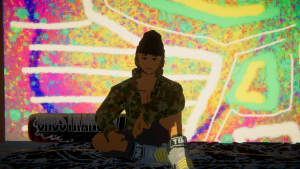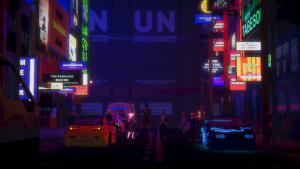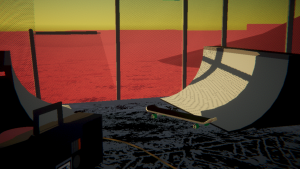Umurangi Generation Review $14.99
Watch It Burn
The concept of the world ending is one of the most tired tropes in video games – and media at large. We have seen an utterly unending slew of different-but-the-same takes on how the end of the world will look, and how humanity will hold on after. That’s why the vibrant, hopeful, and colorful take on the apocalypse presented in Origame Digital’s Umurangi Generation is so effective. It dares to be different.
Picture of a Red Sky
Umurangi Generation is a photography game at its core. Over the course of several levels you’ll comple “photo bounties” – sets of criteria that form a list of photos to take to move on. In one level you might need to take a photo of a disposable camera, a cat, 4 birds and the word “human”, among other objectives. In a different level you may need to take a photo of a shark, though what that means might take some critical thinking. By completing levels you’ll earn new equipment like lenses and a flashbox to light up scenes. Each level also shares a set of secondary objectives, which ask you to find collectibles, get your friends in a group shot, earn a certain amount of money, recreate a postcard, and complete the level’s bounties in a set amount of time. Completing secondary objectives gives you extra equipment and photo editing tools that won’t affect your score, but do provide more creative options.
As you work through this list of bounties you’ll move through spaces showing the stages of an apocalypse in motion. From the first inkling that something is wrong through a sometimes harrowing set of scenes, you’ll see the world fall from a different point of view. This unique perspective gives you a fascinating peek at what everyday life looks like as the world falls apart. Through the lens of your camera you’ll see the despair and pain of a world staring down the barrel of an impossible gun, but there’s more there than misery.
Umurangi tells its story entirely using the environments it drops you in. There is no dialogue, and text is limited to the glowing neon signs, discarded newspapers, and ever present art in the environment. Graffiti, movie posters, notes, and signs all paint a vivid picture of the world’s descent into the unknown, but the thing that is just so wonderful and special about it all is the style with which it conveys all of it.
Going Out In Style
Umurangi Generation leverages an incredibly stylish lo-fi aesthetic most reminiscent of Playstation 1 and Dreamcast games. It combines this visual style with gorgeous lighting, bright colors, and dense environmental design. The result is a staggering visual assault that brings back alley dance battles to light alongside desperate fights for survival. It’s a stunning palate that begs to be documented, which propels you through its levels.
 While completing each set of bounties can be done in a couple of hours, the game’s levels beg to be replayed. Finding the collectibles (film canisters) in each level can be on the frustrating end of the spectrum, but they also force you to take in every angle of each space. After you’ve wrung out every side objective, the levels become canvasses for unleashing your creativity. I can say, even as someone who would normally scoff at the idea of spending hours in a small level just taking photos, Umurangi Generation’s art direction and visuals really pulled me back. Despite a complete lack of violence on the part of the player, its structure reminded me of Hitman. I’ve played dozens of hours of each level in Hitman because there’s just so much to poke at. While Umurangi doesn’t feature the same degree of moving parts, its spaces still have so much to explore and photograph.
While completing each set of bounties can be done in a couple of hours, the game’s levels beg to be replayed. Finding the collectibles (film canisters) in each level can be on the frustrating end of the spectrum, but they also force you to take in every angle of each space. After you’ve wrung out every side objective, the levels become canvasses for unleashing your creativity. I can say, even as someone who would normally scoff at the idea of spending hours in a small level just taking photos, Umurangi Generation’s art direction and visuals really pulled me back. Despite a complete lack of violence on the part of the player, its structure reminded me of Hitman. I’ve played dozens of hours of each level in Hitman because there’s just so much to poke at. While Umurangi doesn’t feature the same degree of moving parts, its spaces still have so much to explore and photograph.
There’s a delicate psychological balance in Umurangi Generation to want to see where the story leads, but also stick around and bask in each level’s glow. I think this speaks to the core of what makes this experience so special: It’s a game about the art that people would make in the face of annihilation. So many pieces of media about the end of the world show humanity’s fall in greys and browns. Umurangi imagines a different apocalypse, one where musicians, painters, poets, dancers and yes, photographers, go out with a bang, not a whimper. This is a game that asks you to revel in the end of the world, and do it alongside your best friends. It makes for a really profound experience as you see how the story ultimately concludes.
Odds and Ends
Unfortunately, not every piece of the puzzle falls perfectly. The levels themselves are gorgeous, but moving through them can feel clunky and frustrating at times. You have a double jump and a crouch, but neither feel quite right and the jumps never quite felt consistent to me. I often found myself mashing the space bar to try to cheat my way up to a ledge by jumping on a person’s head or a thin pole. While in some ways this adds to the DIY feel of getting the perfect shot, it can lead to frustration as well.
The game also fails to define its objectives in some ways. The photo bounties often provide a distance or lens requirement for the photo. “Very close” means right up on top of a subject, which makes sense, but there is a specific moment when you’re asked to take a photograph of a moving object from “nearby” that caused me quite a lot of frustration. The game also provides you with a telephoto lens for longer distance shots, then asks you to use it in tighter spaces to frame awkward subjects in a way that just didn’t compute for me. I’m sure a serious photographer could talk my ear off at how a telephoto has more close up applications than long distance ones, but it still felt counter-intuitive to me.
And finally, there’s those dang film canisters. While I appreciated the way the game forced me to explore every nook and cranny, the barrier the canisters present is a little daunting. This is because to unlock the bonus, non score related equipment in the game, you have to complete all of the bounties and bonus objectives (one of which is finishing everything in under ten minutes) in a single playthrough of a level. While this is enjoyable at first, the levels quickly grow to a degree that makes the prospect less than pleasant. On top of all of this, the game grades your photos with a cash payout, but that payout only serves as a bonus objective in each level, and a final score for each level, with no progression tied to that score. I would have loved a shop that offered the editing tools in exchange for that cash with bonus objectives providing extra money, rather than the way it’s actually structured.
Wave Goodbye
But in the end all of those negatives pale in the face of what Umurangi Generation is. It’s a stirringly unique look at the end of the world. It’s a creative toolbox that presents you with an endless stream of inspiration. It’s a story that resonates deeply with the world we live in. It’s a damn good video game, and you should play it.
Pros
- Unique photgraphy gameplay
- Fantastic style and aesthetic
- Powerful environmental storytelling
Cons
- Clunky movement
- Frustrating collectibles
- A couple of unclear objectives


